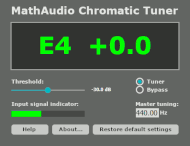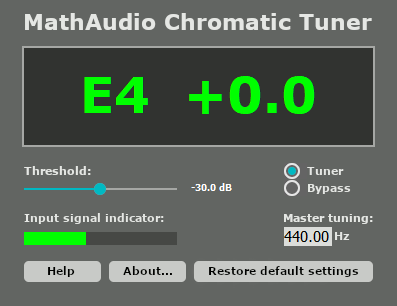
MathAudio Chromatic Tuner VST/AU
- Works with guitars and other string musical instruments.
- Ensures a resolution of +/- 0.1 cent.
- Avoids "dancing needle" and "blinking digits" problems of conventional chromatic tuners.
- Supports full range of sample rates from 44,056 kHz up to 384 kHz.
Chromatic Tuner Help
1. Install one of the following packages:
- Install Chromatic Tuner VST plug-in if you want to use it with a VST compatible host software. If you work on Windows, the version of your VST plug-in (x32 or x64) must correspond to the version of your host software.
- Install Chromatic Tuner AU plug-in if you want to use it with an AU compatible host software.
2. Connect your microphone or pickup to the sound card of your computer
If you use a microphone, place it close to your musical instrument.
3. Start the Chromatic Tuner plug-in
It is convenient to use Room EQ as a first plug-in in your plug-in chain. Make sure that you don't use any reverbs, delays, compressors, limiters and other similar plug-ins before the Chromatic Tuner plug-in.

Fig.1. Screenshot of the MathAudio Chromatic Tuner VST/AU plug-in.
4. Check the presence of the microphone/pickup signal
Make sure that the "Input signal indicator" shows the presence of the mic signal in a green color as it is shown in Fig.1.
6. Play a note on your musical instrument
Don't play the note several times, once is enough. The measurement process takes about 1 second (depends on the CPU speed of your computer). If the micropone/pickup signal is too small and Chromatic Tuner doesn't show the pitch of the note, move the "Threshold" slider left. Cromatic Tuner shows the pitch of every note only once. If it does it several times, move the "Threshold" slider right.
If you tune a 6-string guitar, the standard tuning for a guitar is:
1st string - E4,
2nd string - B3,
3rd string - G3,
4th sting - D3,
5th string - A2,
6th string - E2.
If you tune a classical or an acoustic guitar, 5th and 6th strings resonate when you play 1st or 2nd strings. Higher harmonics of 5th and 6th strings can create an error of tuning. It is recommended to dampen 5th and 6th strings when you tune 1st and 2nd strings as it is shown in Fig.2.

Fig.2. Dampening 5th and 6th strings on a classical or an acoustic guitar.
Note:
If you need to change the master tuning frequency, type the desired frequency in the "Master tuning" windows and press the "Enter" key on you keyboard.
